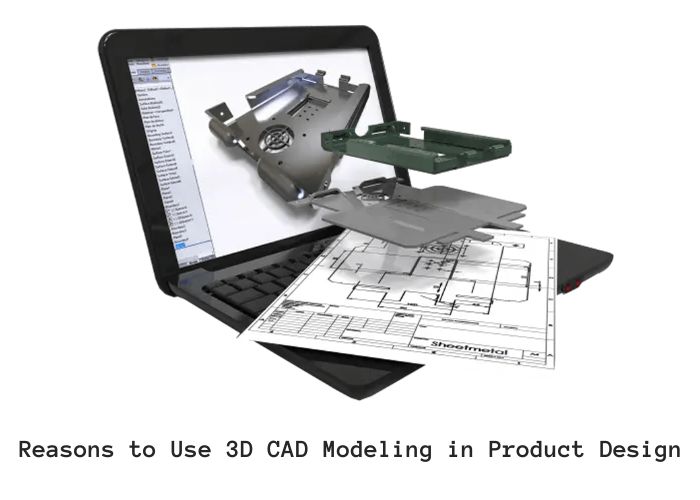Product design is a critical aspect of any manufacturing process. The design phase determines the final product’s look, functionality, and overall performance. To achieve the best results, manufacturers must use advanced tools such as 3D CAD modeling.
3D CAD modeling is the process of creating a 3D model of an object using computer-aided design (CAD) software. This can be done using a variety of techniques, such as:
- Solid modeling: This is the most common type of 3D CAD modeling. It involves creating a solid model of an object by defining its shape and volume.
- Surface modeling: This type of 3D CAD modeling involves creating a surface model of an object by defining its outer shell.
- Wireframe modeling: This type of 3D CAD modeling involves creating a wireframe model of an object by defining its edges and vertices.
Reasons to Use 3D CAD Modeling in Product Design
3D CAD modeling is a powerful tool that can be used to create detailed and accurate models of products. This technology is increasingly being used by product designers to improve the efficiency and effectiveness of their design process.
There are many reasons to use 3D CAD modeling in product design. Some of the most common reasons include:
- Improved communication: 3D CAD models can be used to communicate product designs to engineers, manufacturing teams, and other stakeholders. This can help to ensure that everyone is on the same page and that the final product meets the needs of all involved.
- Reduced costs: 3D CAD modeling can help to reduce the cost of product development by eliminating the need for physical prototypes. This is because 3D CAD models can be used to test and iterate on designs virtually, before they are ever made.
- Improved quality: 3D CAD modeling can help to improve the quality of products by making it possible to identify and fix design flaws early on. This can save time and money in the long run, by preventing the need to recall or repair products.
Read also: Benefits of 3D CAD Modeling in Mechanical Engineering Design
- Increased speed: 3D CAD modeling can help to speed up the product development process by allowing designers to create and iterate on designs more quickly. This is because 3D CAD models can be easily modified and manipulated, without the need to start from scratch.
- Enhanced creativity: 3D CAD modeling can help designers to be more creative, by giving them the freedom to explore new and innovative design ideas. This is because 3D CAD software allows designers to create models of anything they can imagine, without the limitations of traditional 2D design tools.
Best Practices for 3D CAD Modeling in Product Design:
- Start with a clear understanding of the design goals.What are the functional and aesthetic requirements of the product? What are the constraints on the design, such as materials, manufacturing processes, and cost?
- Use the right CAD software for the job. There are a variety of CAD software packages available, each with its own strengths and weaknesses. Choose the software that best suits the needs of the project.
- Create a 3D model that is accurate and complete. The 3D model should accurately represent the physical dimensions, features, and materials of the product. It should also be complete, including all necessary details such as holes, slots, and threads.
- Use 3D CAD to simulate the product’s performance. 3D CAD can be used to simulate the product’s performance in a variety of ways, such as stress analysis, fluid flow analysis, and thermal analysis. This can help to identify potential problems with the design and make necessary changes before the product is manufactured.
- Use 3D CAD to create realistic renderings and animations of the product. This can help to sell the product to customers and partners.
- Use 3D CAD to generate manufacturing data. This data can be used to create molds, tooling, and other manufacturing fixtures. It can also be used to generate instructions for assembly and operation of the product.
By following these best practices, you can use 3D CAD to create high-quality product designs that meet the needs of your customers and partners.
The Future of 3D CAD Modeling in Product Design
Here are some of the ways that 3D CAD modeling is expected to evolve in the future:
- Greater integration with other technologies: 3D CAD modeling is increasingly being integrated with other technologies, such as 3D printing and virtual reality. This will allow designers to create and visualize products in a more realistic way, which will lead to better design decisions.
- More automation: As 3D CAD modeling software becomes more sophisticated, it will be able to automate more of the design process. This will free up designers to focus on more creative and strategic aspects of the design process.
- More collaboration: 3D CAD modeling software will make it easier for designers to collaborate with each other and with other stakeholders, such as engineers and manufacturing teams. This will lead to more efficient and effective product development.
- More accessibility: 3D CAD modeling software is becoming more affordable and user-friendly, making it accessible to a wider range of designers. This will lead to more innovation and creativity in product design.
Overall, the future of 3D CAD modeling in product design is very promising. As the technology continues to evolve, it will become an even more powerful tool for designers, leading to the creation of more innovative and creative products.
Conclusion:
3D CAD modeling is an essential tool in product design. It improves design quality, communication, and the overall design process. 3D CAD Design can save you time and money.
Want to know How much does it cost to hire 3D CAD designers for your next product design project?, Contact the best 3D CAD modeling and design services provider company today.


